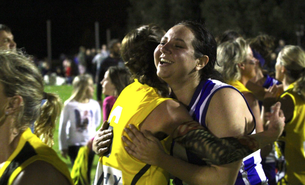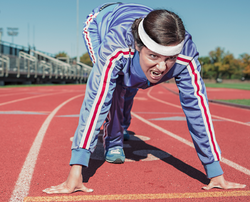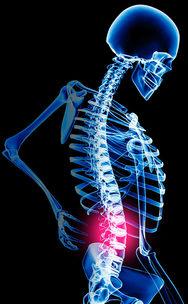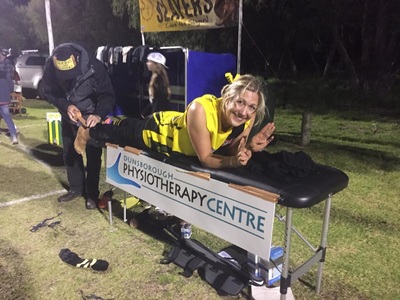Good luck to all Dunsborough Mums this Friday in the South West Challenge! Go Dunsborough Footy Mums Go Dunsborough Footy Mums Ben Liston from Dunsborough Physiotherapy Centre will be supplying his time and expertise this Friday to the Dunsborough Mums Footy Team, hopefully helping to secure a victory over the Margaret River Mums in the much anticipated clash of the titans. Good luck to all those involved in this Friday's South West Footy Challenge.  Sports Rehab at Dunsborough Physio Centre Sports Rehab at Dunsborough Physio Centre For sporting injuries call Dunsborough Physiotherapy Centre (phone: 97553600), or visit our Sports Rehab page (click here) for some great information and advice. Our physiotherapy team has over 100 years of combined experience in sports rehab. www.dunsboroughphysio.com.au Running Retraining shows promise in treatment and prevention of running injuries. Running Retraining Running Retraining What is Running Retraining? Running retraining is a two step process:
Evidence exists linking poor biomechanics to various running-related injuries. Examples of common biomechanical flaws leading to injury include excessive hip adduction and internal rotation (scissoring / inwardly turned thighs), and faulty ankle / foot biomechanics.  Running Injury Prevention Running Injury Prevention Current running injury research suggests that orthotics (insoles) can reduce motion at the foot and more proximally though changes are small and variable. Taping provides larger changes but these are transient. Altered footwear creates highly variable results. Strength training may have minimal impact on running biomechanics. Much more research needs to be done to ascertain the true worth of different treatment interventions. In the interim could running retraining be the answer to lessening running injuries?.........  Lessening knee and lower leg pain Lessening knee and lower leg pain Recent case study results for Running Retraining: 2 studies showed verbal cues could lead to reduced hip adduction during running: a common cause of patellofemoral (kneecap) pain. Another 2 studies showed that anterior shin pain (shin splints) could be lessened with verbal cues to transition from rearfoot to forefoot strike in combination with reducing overstriding by increasing step rate.  Running Retraining helps Running Retraining helps What other running injuries could Running Retraining help with? Experts anecdotally (with the support of 46 studies) suggest running retraining could help with a number of running injuries apart from patellofemoral pain and shin splints including iliotibial band syndrome, plantar fasciopathy (fasciitis), achilles tendinopathy, patellar tendinopathy, proximal hamstring / gluteal tendinopathy, and calf pain.  Good Running Technique - Injury Free Good Running Technique - Injury Free What Running Retraining strategies help with running related injuries?
 Run like the wind Run like the wind What should you do next? Speak to your physio or running coach and get your running technique video recorded. They will then look for flaws and give you advice as to what you need to work on to prevent / overcome injury. Why not join the Dunsborough Running Club (click here) or speak to us at Dunsborough Physiotherapy Centre for advice. Happy running! Work Station Set Up Information Not sure how to achieve a comfortable position at your workstation? Sore by the end of a day in the office? What height should my desk be? Is my office chair set up properly? Check out our new Workstation Set Up page for some common-sense advice.  Need Help?............................................ Check out our Workstation Set Up page for great advice re: achieving ideal postures in the office: click / tap here.  Scoliosis - Cobb Angle Scoliosis - Cobb Angle Free Scoliosis Screening at Dunsborough Physiotherapy Centre. Phone Now: (08) 97553600 Dunsborough Physio Centre is offering free scoliosis screening for all year 4, 5 and 6 students in Dunsborough. What is Scoliosis? Scoliosis is an abnormal sideways curvature of the spine measuring greater than 10 degrees, accompanied by vertebral rotation. The most common form of scoliosis is idiopathic. The cause is multi-factorial, and not completely understood. Depending on the degree of curvature treatment is hugely varied. Common symptoms: back and neck pain and stiffness, obvious altered posture. Risk factors: gender (female), age (prevelant in teenagers), family history. Scoliosis occurs most often during the growth spurt just before puberty (most common in girls aged 9-14). While scoliosis can be caused by conditions such as cerebral palsy, the cause of most scoliosis is unknown. Scoliosis is approximately 8 times more common in girls. If you are female and your mother has suffered from scoliosis you are 20 times more likely to suffer from scoliosis. About 1 in 10 to 1 in 20 girls develop a certain degree of scoliosis in early adolescence. Adolescent idiopathic scoliosis is present in 2 to 4 percent of children between 10 and 16 years of age. About 2% of girls have a curve which warrants medical observation. 3 girls per 1000 will require treatment during the growth phase. If treatment is required the earlier it is undertaken the better the long-term result.  Scoliosis - Adam's Forward Bend Test Scoliosis - Adam's Forward Bend Test How to test for Scoliosis Adam’s Forward Bend Test: with the person leaning forward with straight knees, hands hanging down to the floor, look for a raised rib-cage on one side. A “rib hump” is a hallmark of scoliotic curves greater than 10 degrees.  Scoliosis Scoliosis How to test for Scoliosis Observation: standing up straight, with feet together and arms by side, look from behind for the spine being obviously curved, one shoulder / shoulder blade sitting higher than the other, one shoulder blade more prominent than the other (sticking out more), the head not centered over the body, uneven gaps between the arms and the trunk, or uneven hips (one hip sticking out more than the other).  Scoliometry Scoliometry How to Test for Scoliosis - Scoliometer During the Adam's Forward Bend Test, using a scoliometer, the degree of torso distortion is measured by placing the scoliometer on the thoracic spine / rib cage and then the lumbar spine at the highest point of the curve (apex). At least half of those measured with obvious distortion will have a degree of scoliosis. An angle of 5-7 degrees or greater may warrant further investigation. This angle measurement is different to a Cobb angle measurement (attained via an X-ray).  Cobb Angle Cobb Angle How to test for Scoliosis - X-Rays X-Ray: if a child appears to have a scoliosis an x-ray may be ordered to assess the angle of the curve (Cobb angle). This Cobb angle may need to be re-assesed every 4 - 6 months if the child is still growing. Medical Assessment
Evaluation of growth potential is assessed using the Tanner scale (sexual maturity rating) and the Risser grading system (measuring the stage of skeletal growth). Tanner stages 2 to 3 occur just after the onset of the pubertal growth spurt and correlate to the time of maximum progression of scoliosis. Risser grade is directly correlated with the risk of curve progression. Treatment There is no cure for idiopathic scoliosis. Only 10 percent of children presenting with scoliosis have curves that progress and require medical intervention. Children who have mild scoliosis are monitored closely, usually with X-rays, to see if the curve (Cobb angle) is getting worse. In many cases, no treatment is necessary. 0.2% of children (with a 25 degree curve) may need to wear a brace to stop the curve from worsening. Others with a 40-45 degree progressing curvature may need surgery (0.1%) to keep the scoliosis from worsening and to straighten severe cases of scoliosis. Early intervention is essential to lessen the need for more dramatic intervention (i.e. surgery). If untreated severe scoliosis can cause long-term back pain and breathing difficulty. Contact us at Dunsborough Physiotherapy Centre if you require further advice, or want us to assess your child for scoliosis. We are able to refer for x-rays as appropriate to assess the degree of scoliosis. Need a Bike Fit? Phone Now: (08) 97553600 Health Rebates Apply  At Dunsborough Physiotherapy Centre we offer Bike Fits for riders of any standard, from beginners to elite athletes. Ben Liston - a physiotherapist with over 20 years of physiotherapy experience - has ridden over 50 000kms in recent years on local roads and trails. He is a passionate rider and understands the importance of good bike positioning to achieve maximal performance, but also to ensure comfort on those longer rides. Our Bike-fitting service involves a number of assessment methods including goniometry (to assess joint angles), measurement in relation to horizontal and vertical levels, and the incorporation of a number of research-based scientific equations used by leading bike-fitters around the world. This will allow you to be positioned in the most efficient and comfortable position for your body type and bike choice. Visit our "Bike Fit" Page (click / tap here) for some of great information which will help you to achieve a comfortable and efficient position on the bike. To achieve the ideal position (what we call the fit zone) book in for an appointment at Dunsborough Physiotherapy Centre (private health rebates apply). Phone: (08) 97553600  Swimming Injuries Swimming Injuries Swimming Injuries - Prevention Strategies At Dunsborough Physio Centre we see a huge number of swimming-related injuries each summer. With great beaches and indoor / outdoor pools nearby, large numbers of Dunsborough community members get involved in swimming events such as the Busselton Jetty Swim each summer. Swimming is enjoyed by both young athletes and older age groups. The more recent popularity of triathlons and adventure sports has encouraged the older athlete to extend their "career" in the discipline of swimming. Most swimming injuries are classed as overuse injuries and relate to faulty biomechanics. Swimming has a distinct profile of injuries. Common problems seen among swimmers include "swimmer's shoulder", an overuse injury that causes inflammation of the supraspinatus tendon, sub-acromial bursa, and/or the biceps tendon, overuse injuries of the elbow (golfer's / tennis elbow), knee injuries (including breastroker's knee), ankle injuries (often tenosynovitis / tendinitis), and back injuries (stress fracture / degenerative). Common injuries in swimmers include:- Neck pain: more commonly seen in the older athlete, neck pain is often due to facet joint arthritic change, and disc degeneration +/- nerve root irritation. Muscle innervation and sensation to the shoulder region is predominantly derived from the C5/C6 nerve roots. If these nerve root are irritated due to degenerative change in the neck, shoulder complaints can arise. Arthritic change may also limit neck rotation making correct breathing patterns difficult. Swimmers who do not bilateral breath are more prone to neck pain. Looking forward rather than directly downward, and lifting the head too high when taking a breath can increase load on the neck and create pain. Swimmer's Shoulder: shoulder injuries are the most common injuries seen in swimmers. "Swimmer's shoulder" is a chronic condition involving repetitive impingement of soft tissue under the coraco-acromial arch. Poor technique plays a huge role in this condition which can lead to sub-acromial bursitis, rotator cuff pathology, and long head of biceps irritation. Other shoulder problems in swimmers often relate to instability of the shoulder due to joint capsule laxity and labral (gleno-humeral gasket) damage, caused by repetitive forces placed on the anterior structures of the shoulder joint. Breastroker's knee: this overuse condition often seen in breastrokers, involves sprain to the medial collateral ligament (MCL) due to repetitive rotatory / valgus force applied to the knee during the breastroke kick action. Poor technique is implicated in this condition. Low Back Pain: Hyperextension of the lumbar spine during freestyle and butterfly can create low back pain, as can poor kick technique. In the younger athlete stress fractures are more common, whereas in the older athlete discal degeneration and facet joint degeneration are more common. Biomechanical flaws: Shoulder Injury Prevention There are a number of biomechanical flaws in a swimming stroke action which can lead to shoulder pain. Below are some of the more common shoulder issues associated with poor technique, and ways to alter your technique to lessen your chance of injury. If pain is felt at the beginning of the freestyle stroke or as the arm starts pulling through, this may be due to the upper-arm being positioned behind the back (from shoulder to shoulder): this can cause pain. Swimmers need to be aware their arm position at the start of the stroke: the upper-arm and back have to line up to lessen stress on the shoulder. In freestyle, pain may be felt when the stroke starts because the shoulder is rotated inward when the arm starts pulling through the water. If you’re feeling pain, either decrease the rotation to that side or pull more in front of you (not as wide). This can be a common problem on a swimmer’s non-breathing side because many swimmers lean on that side when they breathe. Make sure not to take the arm across the midline at the start of the stroke as this also can create shoulder impingement issues. Lessening the force of pull at the very start of the freestyle stroke can also lessen the chance of shoulder impingement. Another biomechanical flaw commonly seen in freestylers occurs at the start of the recovery phase. If pain is felt early in the recovery phase the swimmer might be exaggerating the finish motion too much, and the hand and arm are too high when the recovery starts. Keep the arm lower to the water to start the recovery. In backstroke, many swimmers press down with their hand and arm to start the stroke. This can definitely make the arm cross behind the back. If you’re feeling pain, either rotate more to that side or aim for a shallower pull. In butterfly pain may develop when the swimmer presses deep with their chest and the hands stay high at the surface. If you feel pain, press forward with the chest and aim for a flatter stroke. General Injury Prevention Strategies: ensuring correct technique, core strengthening, mixing strokes during training, adequate rest, strengthening the rotator cuff muscle group, strengthening scapular stabiliser musculature, maintaining equivalent amounts of internal and external rotation around the shoulder, learning to bilateral breath, and carrying out neck and low back flexibility exercises can lessen injury rate in swimmers.  Core Strengthening Core Strengthening If you require rehab exercises following an injury, following surgery, or for management of a long-term condition visit our Dunsborough Physiotherapy centre website and visit our "Physio Exercises" page found under the "Physio Services" heading. We have hundreds of exercise options available including strengthening exercises, flexibility exercises, core strengthening exercises, and joint range of motion exercises. For more detail speak to one of our physiotherapists at Dunsborough Physiotherapy Centre today. phone: 97553600 website: http://www.dunsboroughphysio.com.au  Dunsborough Physio Centre now open on Saturdays Dunsborough Physio Centre now open on Saturdays Can't make it in to Dunsborough Physiotherapy Centre during the week?..........no worries! Dunsborough Physiotherapy Centre is now open on Saturdays from 10:00am - 1:00pm. Call us for an appointment today. Phone: 97553600. Don't forget to visit our website for lots of great physio information and advice. http:www.dunsboroughphysio.com.au Dunsborough Physiotherapy Centre continues to supply the latest evidence-based physiotherapy services using cutting-edge techniques and technologies. Check out our new "Physio Exercises" page (click / tap here) for some great rehab exercise options to strengthen your core, improve flexibility, gain greater global strength and relieve pain.  Ben Liston hard at work Ben Liston hard at work Congratulations to the OLC and DPS Mums for a hard fought and entertaining footy game last Friday night. Dunsborough Physiotherapy Centre, like many other local businesses donated money towards the fundraising efforts of the OLC and DPS mums. Ben Liston from Dunsborough Physiotherapy Centre provided pre-game taping for the OLC Slayers, and then provided physiotherapy treatment to the OLC mums during the game against the Dunsborough Primary School Dragons. Luckily there were few injuries during the game: a few mild muscle strains towards the end of the game which were treated by physiotherapist - Ben Liston. Well done to all those involved. See you next year! No Guts, No Glory Super Coach - Red Winners are Grinners Ben Liston at work  Susy Turnbull Susy Turnbull Dunsborough Physiotherapy Centre warmly welcomes Susy Turnbull to the Dunsborough Physio team. Susy has over 10 years of physiotherapy experience and has worked in a number of physiotherapy settings both within Australia and overseas. Susy has worked as a physiotherapist in both New Zealand (including a stint in Queenstown where she developed a love of snowboarding) and Canada. Whilst working in New Zealand Susy supplied sports physiotherapy services to elite netball, soccer and rugby teams. During her time in Canada Susy supplied physio treatment and sports rehab to college athletes. In Western Australia Susie has run classes aimed at reducing osteoporotic change and improving balance to limit falls risk in clients. She has also worked with inpatients supplying post-operative care.  Gym Programs Gym Programs As a physiotherapist Susy has designed numerous supervised individualised gym programs for her clients, helping to improve strength, flexibility and general conditioning. She has also instructed "kombat" classes in a gym setting. Susy supplies hydrotherapy services for those who benefit from the warmth and bouyancy of water. Susy has worked extensively as a physio supplying rehabilitation programs for worker's compensation claim clients and motor vehicle insurance trust patients. She is well versed in the area of return to work planning, workplace visits, and comprehensive reporting requirements, and has regularly been involved in discussions and negotiations with employers to ensure the best outcomes for her clients. Susy is a keen sporting competitor. She is an experienced netball player, and snowboarder. Susy has previously participated in soccer and basketball. Susy has competed in half marathons, cycle challenges and mud races and regularly attends the gym. If you are requiring physio services in Dunsborough Susie is able to provide high quality physiotherapy care as part of the Dunsborough Physiotherapy Centre Team. Visit our website: http://www.dunsboroughphysio.com.au - click / tap here |
AuthorBen Liston of Dunsborough Physiotherapy Centre has over 25 years of physiotherapy experience. Archives
September 2016
CategoriesAll Hydrotherapy Massage Therapy Real Time Ultrasound RICER Injury Management Snow Skiing And Snowboarding Injury Prevention SPRIG Program (Injury Prevention Program For Children And Adolescents) Surfing Injury Info Winter Sports Injury Info |
Proudly powered by Weebly





 RSS Feed
RSS Feed